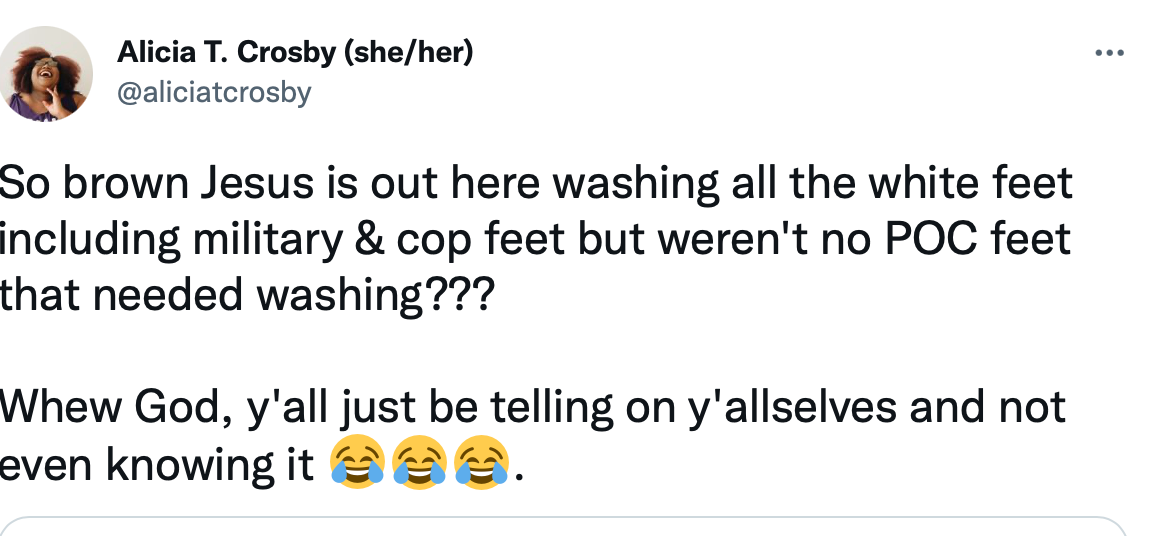Dear readers,
Last week, a work of art from the “Footwashing Series” from SaltandGoldCollection on Instagram made its way around the interwebs. Here it is:
When I first saw it, I was moved by the message I received: Jesus showing love via a visible representation of servanthood to all including a prisoner, a police officer, a gay pride advocate, an anti-vaccine advocate, a pro-vaccine advocate. I did not see this as a statement of Jesus’ approval or disapproval of each individual’s belief and behavior. It was showing that he has laid down his life to love and to serve even his enemies, which according to the scripture, includes all of us. It was depicting unconditional love.
But in my blindness, I missed something very important. And once I noticed it, I realized how much more I had to learn in the very area that I have been trying to learn for the past few years.
On first seeing this, did you notice that Jesus has dark skin and everyone he is “serving” has light skin? In a painting about Jesus laying down his life, his power, and extending his love to all, why weren’t any of the recipients of these things made to look like the dark skinned Jesus that is pictured? If you are a person of color, you probably noticed this immediately. If you are white, perhaps, like me, you did not. As much as I like to believe I see things more clearly now as far as racial profiling, racial injustice, and implicit bias are concerned, my oversight shows that I still have to humbly pursue listening and learning, letting it all seep in. It all takes a while to unlearn and to try to understand. And these things must be done in order to grow a sustained capacity for empathy. We must be given eyes to see.
Here are a few tweets from Black brothers and sisters who immediately called out the problematic racial power dynamics in the painting. How exhausting this must be—the same story over and over and over:
I want to apologize for my incredible oversight. For seeing this painting without REALLY seeing it. And then for sharing it, still without seeing it.
I do want to be fair to the artist and post a few images from her Instagram page that DO show Jesus washing the feet of Black men. Although these are very good and very beautiful—the original painting that was making the rounds is still very problematic because of the omission of images like this. I think that our reaction to it tells us a lot about our ability to see and empathize with brothers and sisters of color.
In some of the critiques, I did note some points of theological concern (interestingly, most of these were from white folks, even some white pastors).
A few people said that Jesus would not ever wash the feet of the police, representatives of the “empire.” Why would he stoop down to serve the oppressor?
They also said that because the image depicts Jesus washing the feet of people on “both sides” of a debate (for example, the vaccine debate), that it was saying that Jesus legitimates and endorses both sides.
I want to tackle the second concern first by saying that the Bible clearly says that Christ came to lay down his life for his enemies. His show of unconditional love for them does not mean that he approves their behavior.
"It is not the healthy who need a doctor, but the sick.” -Mark 2:17
Of course, the people represented in these images might not even know they are sick. But neither did Saul (Paul), neither did Matthew, etc. etc. It is unconditional love shown by Christ that turns the heart. And love does not mean total agreement. We are also called to speak the truth in love. But it does mean seeing the Imago Dei in another human being and showing compassion, thinking of others better than ourselves.
My response to the first comment follows on from this. Would Christ only serve those who were oppressed and powerless? We certainly see him taking up the concerns of the poor and siding with the oppressed. But, once again, what about Saul, a known terrorist who had been killing followers of Christ? He did not deserve to have his feet washed, did He? Of course, we don’t see Jesus washing his feet. But He does stop him in his tracks, confront him, redeem him. Saul becomes Paul not because he deserved it, but because Jesus chose to die for and redeem even the “worst of sinners.”
It seems to me that ignoring Jesus’ love for sinners, for his enemies, ignores the very core of the gospel.
For the rest of this newsletter, I want to share a short excerpt from my book about the love of enemies (the focus of the last chapter):
******
We struggle with loving our enemies, especially as we struggle to see them as God sees them, beloved by Him and made in His image. We see Christ’s anger and deep love together in Matthew 23 when he rebukes the religious leaders, calling them “hypocrites,” “white washed tombs,” “a “brood of vipers.” He does not mince His words. But the chapter ends like this:
“Jerusalem, Jerusalem, you who kill the prophets and stone those sent to you, how often I have longed to gather your children together, as a hen gathers her chicks under her wings, and you were not willing. Look, your house is left to you desolate. For I tell you, you will not see me again until you say, ‘Blessed is he who comes in the name of the Lord.”
Both the rebuke and the tender picture of maternal care are acts of love as Christ is speaking the truth boldly in order to allow a chance for repentance. As we know from scripture (and maybe from life), the religious people who don’t know their spiritual sickness are often the ones who struggle the most to change.
Matthew 23 is prominently featured in the Appendix to The Narrative Life of Frederick Douglas where the formerly enslaved author quotes large portions of it when exposing the hypocrisy of religious slaveowners that used decontextualized scripture as a justification to brutalize, rape, and turn human beings into commodities. In doing this, he discerns a prophetic distinction between the “Christianity of this Land” and “The Christianity of Christ”. Douglass is deeply, righteously angry, but his anger—at least on paper—never devolves into hatred of his enemy. Even his rebukes are full of mercy. He realizes that power corrupts, and, at one point, he says that “the institution of slavery is just as damaging for the slaveholder is it is for the slave.” The spiritual damage of the oppressor’s heart is something to be pitied. And the oppressor could be any one of us when we get a taste of power. Kevin Smith, pastor of New City Fellowship, Chattanooga, claims that “God loves the oppressed AND the oppressor.” This is quite a hard pill to swallow. The love, strength, and forgiveness that we see in the history of the African American Church—America’s true persecuted church—is an example of love for our enemies that is truly humbling to witness.
Jesus called Matthew, a tax collector, a man who had aligned himself with the oppressors and was benefitting from their power while harming his own people. He was a traitor, but Jesus still saw his intrinsic value. Jonah was an arrogant self-righteous racist—but the Lord called Him. Saul was, to some degree, a religious terrorist. But Jesus appeared to him on the road to Damascus, an apocalyptic intervention that dramatically altered the course of his life. It is important to reflect on this lavish grace and these miraculous transformations in order to see and hear from a Kingdom perspective.
As always, thank you so much for reading!
Until next time,
Mary










